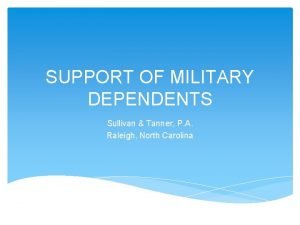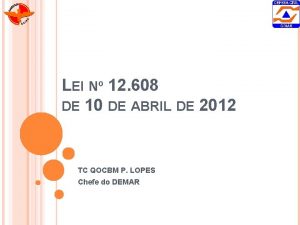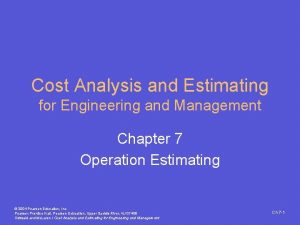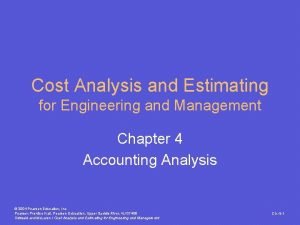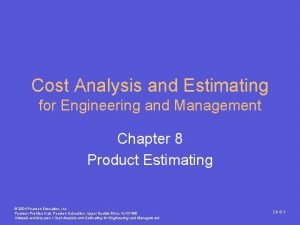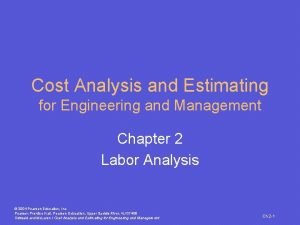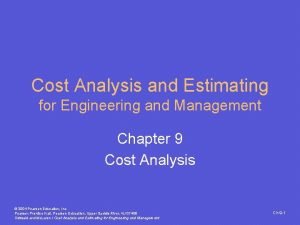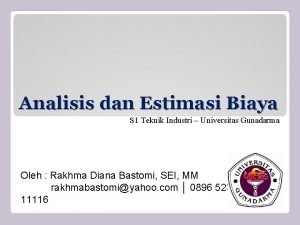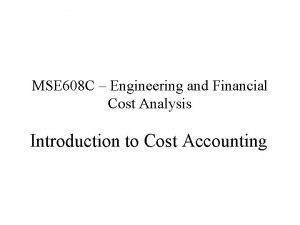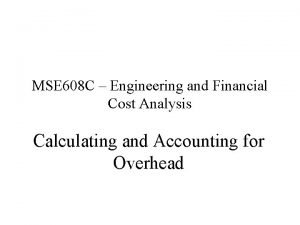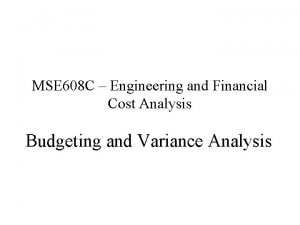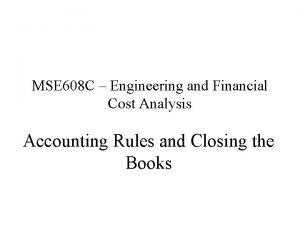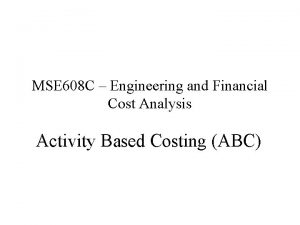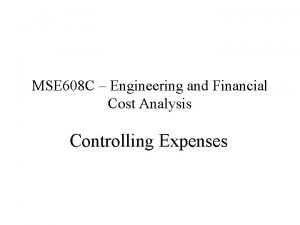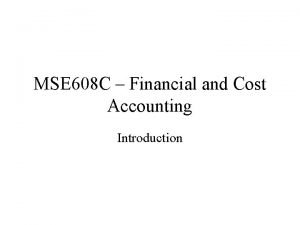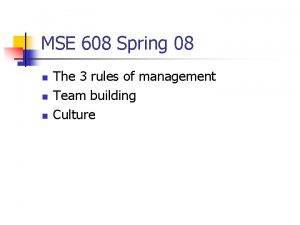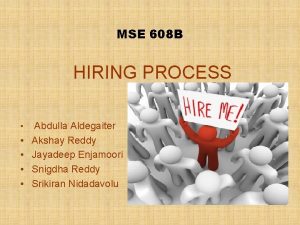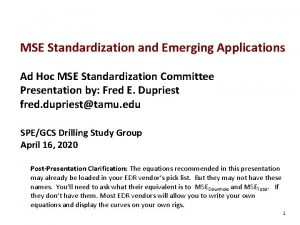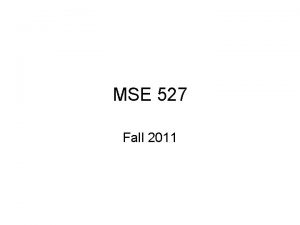MSE 608 C Engineering and Financial Cost Analysis






















- Slides: 22

MSE 608 C – Engineering and Financial Cost Analysis Financing a Business

Business Structures • Sole Proprietorship • Partnerships • Corporations – S Corporation – Private – Publicly traded

Financing a Business • Two Sources of Cash – Debt • • Commercial Loans Bonds Leasing Trade Credit – Equity • • • Personal Savings Private Investors Venture Capitalist Stocks Retained Earnings

Debt Financing • • Commercial Loans Bonds Leasing Trade Credit

Equity Financing • • • Personal Savings Private Investors Venture Capitalist Stocks Retained Earnings

Stocks • Common Stock – No fixed maturity – No obligation of payment of dividends – Right to vote for the directors • Preferred Stock – No fixed maturity – An obligation to receive dividends – Convertible to Common Stock • Options – Strike price = stock price on date option is granted – A claim on the Equity ownership that will dilute the ownership position.

Which Is Best? • Risk – Debt more risky than Equity • Costs – Equity is more costly than debt financing – Publicly-traded companies have higher costs associated with complying with accounting regulations. • Control of the Company – Equity financing usually requires giving up some management control of the business.

Debt Leverage • Long-term Debt to Total Capitalization = Non-current liabilities Total Capitalization – Total Capitalization = Long-term Debt + Owners’ Equity • Highly (Debt) Leveraged companies will have wider swings in Earnings Per Share (EPS) – Fewer owners to share the wealth when business is good – Interest payment have a bigger effect on Net Income when business is poor

Assessment • What are the two methods for financing a business? • What are the differences between an Angel Investor and a Venture Capitalist? • You are starting a online Internet company. What do you think will be you sequence of financing, and why?

Overstating Revenues • Selling to Related Entities – The party must be an “arms length” • Stuffing the Channels – Excessive quantities to distributors/retailers – Extended credit terms • Installment sales at Low Interest Rates – Artificially low interest rate to calculated timeadjusted cash flows = higher recognized Revenues

Overstating Revenues • Using funds from Over-funded Reserves – Reserves obligation will fluctuate – Using over-funded Reserves can result in under -funding at later accounting periods. • Treat Nonrecurring Dispositions as Ordinary Income – “Below-the-line” gains are nonrecurring – Can over-state Income from normal business operations

Overstating Revenues • Record Income for Future Services – “Bundled price” includes deferred expenses – May underestimate value of future services to over-state current Revenues

Understating Expenses • Unrealistic Depreciation/Amortization – Allowable to use a different method for financial reports from Tax (IRS) reporting • Capitalize Questionable Expenses – Capitalization or Expense? – Capitalization = deferred expenses – Match Expenses to Revenues

Understating Expenses • Ignore the cost of Stock Options – When exercised • Increases outstanding shares and affects EPS • Loss of value to company if strike price below market price – How to value? • Must have some value to have meaning to recipient • Valuation methods require making assumptions • Sarbanes-Oxley requirements

Understating Expenses • Delay the Accrual of Expenses – Reserve accounts – Contra-asset accounts • Overstate Assets or Understate Liabilities • Delay Recognizing Declining Asset Value

Overstate Assets or Understate Liabilities • Delay Recognizing Declining Asset Value – Dressing up the Balance Sheet • Accounts Receivable and Allowance for Doubtful Accounts • Loans Receivable and Allowance for Bad Debt • Inventory and Allowance for Obsolete Inventory • Fixed Assets and writing off obsolete assets • Investments and unrealistic market valuation – Conservatism requires the Accountant to understate assets

Failure to Disclose Liabilities • Must disclose all liabilities – Pending lawsuits – Pension costs – Toxic cleanup – Deferred Executive compensation • Use Unconsolidated Debt – Offload debt from one affiliated to another – Dresses up Balance Sheet – Relationships must be reported in footnotes

What Did They Do Wrong? • World. Com (Bernie Ebbers) – $3. 8 B in operating expenses booked as Capital Expenditures. • Fee paid to other telecommunication companies for use of their telephone networks.

What Did They Do Wrong? • Adelphia – John, Timothy and Michael Rigas + others • Company was personal “piggy bank” – John Rigas withdrew $1 M per month – $3 B line of credit for John Rigas but the company responsible if default – Hid $2. 3 B of debt in off-Balance Sheet affiliates

What Did They Do Wrong? • Enron – Huge losses in two investments backed by Enron stock, Avici and New Power, not reflected in public filings – Andrew Fastow ran two partnerships that were treated as separate companies, LJM 1 & LJM 2 • Financed by Merril Lynch & Co. • Purchased three Nigerian barges (assets) from Enron at end of year to boost profits. • Secret promise to repurchase barges later at a higher price. – Lay unfairly represented Enron’s true financial condition to investors.

What Did They Do Wrong? • Fannie Mae – Doctored earning over 6 years • Did not record Revenues in the period they occurred. – Misstated earnings by $10. 6 B – Hundreds of million in bonuses – Purchased some of their own loan packages

Assessment • What are three generic types of business structures? • What is the problem with using money in an over-funded Reserve (contingency) account? Is it legal? • If you sell to your own company can you recognize this as Revenues? What principle is considered in this case?
 Army bah regulation 608 99
Army bah regulation 608 99 Process mining
Process mining Lei nº12.608/12
Lei nº12.608/12 Mse total cost
Mse total cost Cost analysis and estimating for engineering and management
Cost analysis and estimating for engineering and management Cost analysis and estimating for engineering and management
Cost analysis and estimating for engineering and management Cost analysis and estimating for engineering and management
Cost analysis and estimating for engineering and management Cost analysis and estimating for engineering and management
Cost analysis and estimating for engineering and management Cost analysis and estimating for engineering and management
Cost analysis and estimating for engineering and management The relative proportion of variable fixed or mixed
The relative proportion of variable fixed or mixed Analisis estimasi biaya
Analisis estimasi biaya Cost accumulation and cost assignment
Cost accumulation and cost assignment Cost accumulation and cost assignment
Cost accumulation and cost assignment Cost accumulation and cost assignment
Cost accumulation and cost assignment What is a period cost on the income statement
What is a period cost on the income statement Dennis geyer
Dennis geyer Standard costing definition
Standard costing definition Distinguish between average cost and marginal cost
Distinguish between average cost and marginal cost Cost control and cost reduction difference
Cost control and cost reduction difference Job order cost system vs process cost system
Job order cost system vs process cost system Ordering cost and carrying cost
Ordering cost and carrying cost Difference between opportunity cost and trade off
Difference between opportunity cost and trade off Cost control and cost reduction project report
Cost control and cost reduction project report
